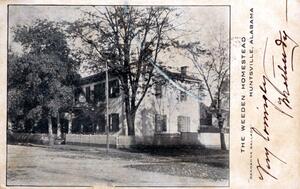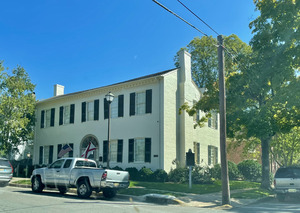Joshua Panasa, Fall 2024
Located at 300 Gates Street, Huntsville, Alabama, the Maria Howard Weeden Home was constructed in 1819. A structure ahead of its time, the Weeden Household is a beautiful, two-story, Federal-style building made from white brick and intricately designed woodwork. In fact, many elements of the home were completely hand crafted, and from the slightly disjointed bricks to the uneven cuts of glass, the home’s subtle irregularities add to its unique beauty. Being built on unstable soil, almost none of the bricks are properly aligned anymore leading to recent efforts to inject cement into the foundation in an attempt to stabilize the leaning house. From 1973-1981, restoration efforts were made in order to bring back the at-the-time dilapidated structure back to a presentable condition. The building was converted into a museum that eventually opened in 1981, still being available for visit today. While being an important part of architectural design in the Huntsville area, the home also holds a historical importance when it comes to the people who lived in the home, and the things the building was used for.
Then, the structure was originally built by Henry Bradford in 1819. Being a merchant, Bradford came to Huntsville, Alabama, after the city went through an economic boom, the first in the city’s history. In building the home, Bradford was heavily inspired by the likes of Robert Adam, an English architect who became famous for his signature “Federal” home designs. Simple and elegant, the designs of these homes abandoned the heavily decorated interiors of the Georgian period styles of home popular at the time. Adam’s style was derived from the ancient interiors of Roman houses that saw more simplistic layouts for many of their interior features. Henry Bradford took this inspiration and based his construction of the Weeden House on these design choices. In fact, the Weeden House is still one of the best examples of a home based around Robert Adam’s Federal home designs still standing today.
After building the home, Bradford took residence within it though not for very long. Living in the house from 1819-1821, Bradford sold the home to a man named John Read and after living in it from 1821-1824, he ended up selling the home to U.S. Senator John McKinley who owned it from 1824-1829. McKinley ran as a U.S. Senator from Alabama between 1826-1837 and later an associate justice of the U.S. Supreme Court between 1837-1852 adding a level of political value to the home. After McKinley passed away in 1852, Bartley Martin Lowe and Martha Betts Chambers took up residence in the home between the years 1829-1845. Afterwards, the home was sold to the notable Dr. William Donaldson Weeden and Jane Eliza Books Weeden. The two would renovate the home, finishing the project in the late 1840s and making additions like a front portico. A portico is a structure that would usually be built into or along a home with columns that would support an overhanging roof, similar to a porch. In 1846, however, tragedy struck when Dr. Weeden died on a trip to New Orleans. The now widowed Jane E. Weeden would now have had to take care of the newest member of their family, the six month old Maria Howard Weeden. While many have called the structure their home, the one most people tend to know the site by is this Maria Howard Weeden (1846-1905), an artist who became internationally famous for her poems and paintings.
Maria Howard Weeden grew an early, tender life as she eased into her place in the world. Being the youngest of her siblings, she was treated with care and compassion which allowed her to firmly grasp her impeccable talent in art related fields even before the age of ten. Instructed by William Frye (1822-1872), a portrait painter from Germany, for two years, a young Howard would draw various portraits and objects with smooth precision. While we do not know exactly which school she went to, we do know that Weeden continued her passion in art. During this time, however, the American Civil War was brewing, and the Weeden family was about to feel the effects. At the end of the war, the family was forced to evacuate their home, and the structure was used as a shelter for soldiers. When the family returned, the house was like a husk, plundered and reduced by the war. This did not stop Weeden, however, as she quickly picked up a brush and got back to work on what she knew best. She would quickly become recognized and revered as an artist, with many of her paintings being extremely unique for the time. In fact, Weeden had relatively little experience and knowledge of technique compared to other artists of the time, though this often gave her artwork an edge as it added an unconventional charm to her work. As she grew older, Weeden would also become famous for painting former slaves as her mother was recorded owning several slaves at one point which influenced her work. Weeden would continue to grow in fame as her life went on, having her artwork displayed internationally in the 1890s in Nashville, Berlin, and Paris. She would also have her poetry published between 1898-1904 in Boston and have articles in newspapers beginning in 1868. In the home itself, Weeden would also go on to teach art classes. Maria Howard Weeden is often seen as the namesake of the Weeden Home with her art and stories being inspirational for decades to come eventually culminating in the Weeden House Museum and Garden which can be visited even today.
Now, the Weeden House Museum and Garden still stands tall with clean white brick and a few renovations. The house was vacant in 1972, allowing for renovations to be made from various fire damages. From 1973-1981, the house was continuously renovated for use as a museum by the Twickenham Historic Preservation District Association (THPDA) and the City of Huntsville. Several private donations and a federal HUD grant also provided the financial support in order to complete the restorations. In the present day photograph, it can be seen that non-original additions to the home were removed. This included the front portico the Weeden family added which has now been completely removed. Another major restoration was made in 2002 with the primary financial responsibility now being handled by the THPDA. In 2024, commercial roads have been laid out all around the home with many new buildings like churches, restaurants, and business offices being constructed nearby. Many old homes and neighborhoods still stand closeby as well providing more history to the area. Many trees, as well as the fence surrounding the property have been taken down to accommodate the road. Other than these details, however, a large majority of the Weeden Home remains intact. Aspects like the chimneys are still largely the same as their 1906 counterpart. It is quite nice to see a historic home be so well preserved, and to this day, visitors can book a tour of the museum discovering the iconic Federal styled house. The Weeden Homestead is a site of many personalities. Starting off as a simply well crafted residence, to a Civil War shelter, to the home of an internationally famous artist, the Weeden House lives on today sharing its many tales through its museum. As the beautiful structure still stands, may the future of the property be bright and may many more bear witness to its wonderful history.
Bibliography
Roberts, Frances C., and Sarah H. Fisk. 2011. Shadows On The Wall: The Life And Works Of Howard Weeden. N.p.: Literary Licensing, LLC.
The Historic Huntsville Quarterly. 1981. “The Maria Howard Weeden House.” The Structure 8, no. 1 (9): 18.
Weeden, Howard (1990) "My Mother's Garden,"
United States Department of the Interior National Park Service. 1990. National Register of Historic Places Continuation Sheet, This form is for use in nominating or requesting determinations for individual properties and districts. No. 7. Twickenham Historic District, Madison County, AL, Alabama: National Park Service. https://www.historichuntsville.org/wphhsvf/wp-content/uploads/2018/08/Twickenham-National-Register-Nomination-.pdf.
Acknowledgements
Benjamin Griffin for driving me to take the present day photograph
Honors College and UAH Library Staff for helping me looking through the online and in person resources
Professor Grimsley for directing the class with the “Then and Now” research project
Cosmo O’ Neil for helping me with citations and source direction
Sean Meyerhoff for assisting in the essay writing process
Alyssa N Walldorf
Asia T Dezenberg
Holden B Brolliar
Thomas E Ehemann
Wesley Carter
|


